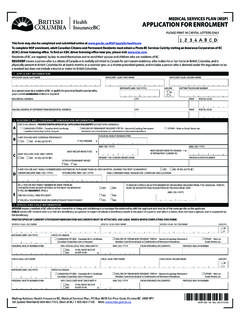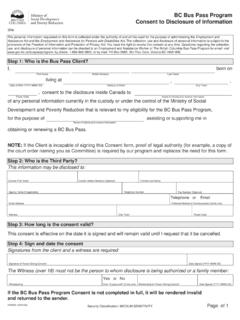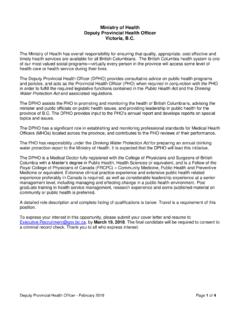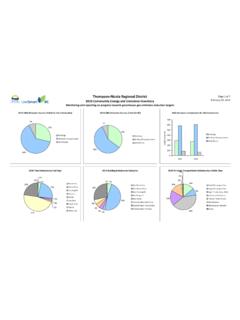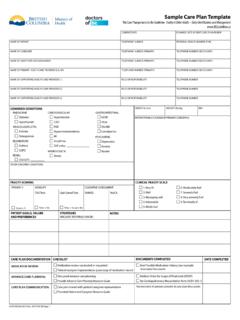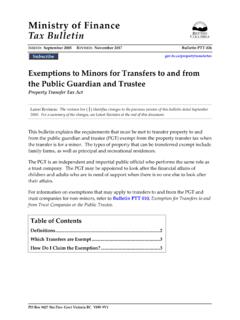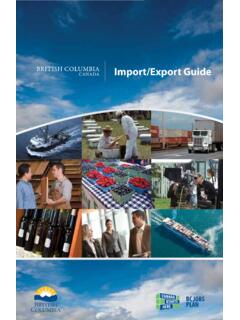Transcription of OIL AND GREASE in WATER by HEXANE EXTRACTION AND ...
1 Organics Revision Date: Nov 6, 2015. OIL AND GREASE in WATER by HEXANE EXTRACTION AND. GRAVIMETRY PBM. Parameters Oil and GREASE Mineral Oil and GREASE EMS Codes & The MDLs listed below are achievable for this method in a typical laboratory environment. MDLs Ensure that the detection limits reported by the laboratory are sufficient to meet any applicable regulatory standards. Compound Approx MDL (mg/L) EMS Code Oil and GREASE 2 0003 X055. Mineral Oil and GREASE 2 N/A. Analytical Method Liquid-liquid EXTRACTION with HEXANE , treatment with silica gel (for Mineral Oil and GREASE only). and gravimetric determination (PBM). Introduction This method is applicable to the quantitative determination of Oil and GREASE ( HEXANE extractable material, HEM) and Mineral Oil and GREASE (silica gel treated HEXANE extractable material) in WATER . Oil and GREASE provides a measure of HEXANE extractable non-volatile oils and greases which may be of either petrogenic or natural origin. Mineral Oil and GREASE determines only non-volatile, non-polar oils and greases.
2 Most natural oils and greases ( vegetable oils, animal fats) are polar, and are excluded from the Mineral Oil and GREASE parameter. Method Summary A WATER sample is acidified to pH < 2 and extracted three times with HEXANE (or hexanes ) in a separatory funnel. The extract is dried with sodium sulfate, the solvent and any volatile components are evaporated, and the residue is weighed with a 4-place balance. For Mineral Oil and GREASE , polar material is removed by treatment of the HEXANE extract with activated silica gel prior to filtration, solvent evaporation, and gravimetric determination. Matrix Fresh WATER Waste WATER Saline WATER Interferences and HEXANE extractable material recovered by the Oil and GREASE method may include non-volatile Precautions petroleum hydrocarbons, waxes, animal fats, mineral and vegetable oils, soaps, sulfur compounds, organic dyes, chlorophyll, etc. Mineral Oil and GREASE may include any of the above components that are sufficiently non- polar such that they are not irreversibly adsorbed to activated silica gel.
3 Caution is advised with the interpretation of results. This method is designed to fully recover most organic compounds with boiling points that are equal to or greater than that of n- hexadecane (nC16; 297 C). It is not applicable to the measurement of low boiling organics like solvents or gasoline range fuels. The lighter portions of middle distillate petroleum fuels ( diesels, fuel oils) may be partially lost during the solvent removal step of this method. A high bias may be achieved from co-extractives which are not oils or greases. Samples with high solids content, TSS > 500 mg/L may result in a low bias due to sorption of the material onto the insoluble fraction. Sample Handling and Container: 1L Glass Bottle, wide mouth with PTFE-lined lid. Smaller volumes may be Preservation collected and extracted provided that the detection limit is raised accordingly. Field Duplicates require a second container. Preservation: pH < 2 using HCl or H2SO4 . Stability Holding Time: Extract within 28 days of collection.
4 Raw samples arriving at the laboratory should be preserved to pH < 2 upon receipt to inhibit microbial degradation. Storage: Samples should be kept at 10 C during transport to the laboratory. Refrigerate samples at 6 C prior to analysis. Analytical Procedure Detailed procedures are not provided in this method. Refer to the EPA Method 1664 for further guidance. Samples should be visually assessed and checked for pH prior to EXTRACTION . If not already done, adjust sample pH to < 2 using HCl or H2SO4. Sample volumes are measured gravimetrically or volumetrically, to at least the nearest 10 mL. Samples are sequentially extracted with three aliquots of HEXANE in a separatory funnel. Samples are shaken vigorously for 2 minutes per EXTRACTION . The first aliquot of HEXANE is used to rinse the sample container so that its entire contents are transferred to the EXTRACTION vessel. The ratio of solvent to sample should be no less than 1:20, 50 mL of HEXANE (per EXTRACTION ) per 1 L of sample.
5 The solvent extracts are passed through a drying funnel containing anhydrous sodium sulfate and combined together. Emulsions frequently occur during the EXTRACTION of many oil and GREASE samples. When encountered, precautions must be taken to ensure that adequate EXTRACTION efficiency is obtained. Centrifugation, ultrasonication, and the addition of NaCl are recommended to separate emulsions. For Oil and GREASE , the extract is evaporated to dryness at ambient temperature (~20-25 C). Following evaporation, residual WATER , solvent, and other volatiles are removed by heating in an oven at 50-60 C for 30-60 minutes or by continued evaporation at ambient temperature, prior to gravimetric determination of the residue using at least a 4 place balance. If the final evaporation step is done at ambient temperature, gravimetric measurements must be done to constant weight (see prescriptive elements). For Mineral Oil and GREASE , the HEXANE extract is cleaned up with 100% activated silica gel (60 Angstrom pore size, ~70-230 mesh) using either an in-situ or column based process.
6 Extracts may be cleaned up directly after EXTRACTION , or may be reconstituted into HEXANE after an initial Oil and GREASE determination. Activate silica gel by drying at 200-250 C for at least 16 hours. A default amount of grams of silica gel is recommended, which is generally assumed to have an adsorptive capacity for up to 100 mg of HEM. For samples that are known or expected to exceed 100mg of HEM, additional silica gel may be used, or a suitable quantitative portion of the extract may be treated with silica gel prior to the Mineral Oil and GREASE analysis (if necessary, another portion of the extract may first be tested for Oil and GREASE to determine the total HEM content). After silica gel treatment, the extract is filtered and then evaporated to dryness at ambient temperature (~20-25 C). Following evaporation, residual WATER , solvent, and other volatiles are removed by heating in an oven at 50-60 C for 30-60 minutes or by continued evaporation at ambient temperature, prior to gravimetric determination of the residue using an analytical balance (4 place minimum).
7 If the final evaporation step is done at ambient temperature, gravimetric measurements must be done to constant weight (see prescriptive elements). Performance Any analytical method options selected for this analysis must meet or exceed the method Requirements validation performance requirements specified below: Accuracy and Precision requirements apply to measures of long term method performance (averages and standard deviations). Achievement of these requirements is to be demonstrated during initial and ongoing method re-validation studies. They do not constitute acceptance criteria or Data Quality Objectives for individual Quality Control samples. For Initial Validations, averages of at least 8 Lab Control Samples must be assessed (preferably taken from multiple analytical batches). Ongoing Re-validations (performance reviews) should assess QC data encompassing longer timeframes ( 1 year). A minimum frequency of 2 years is recommended for Ongoing Re-validations. Accuracy Requirement: Laboratories must demonstrate method accuracy (measured as average recovery) through repeat analysis of Lab Control Samples at concentrations above ten times the MDL.
8 Average accuracy must be between 80-120% for both Oil and GREASE and Mineral Oil and GREASE . Precision Requirement: Laboratories must demonstrate method precision through repeat analysis of Lab Control Samples at concentrations above ten times the MDL. Precision must be 15% relative standard deviation (%RSD) for both Oil and GREASE and Mineral Oil and GREASE . Where the laboratory's method does not meet these accuracy or precision requirements for specific parameters, the method may still be used, but reports must indicate that results are semi-quantitative or qualitative, and the established performance should be provided. Quality Control Summary of QC Requirements QC Component Minimum Frequency Minimum Data Quality Objectives*. Lab Control Sample (LCS) 1 per batch 70-130% recovery (max 20 samples). Method Blank (MB) 1 per batch Less than reported DL. (max 20 samples). Reference Material (optional) 1 per batch N/A. (max 20 samples). Field Duplicates Recommended Not specified * Minimum DQOs apply to individual QC samples, not averages, at levels above 10x MDL.
9 Laboratories should report qualified data when DQOs are not met. QC Details Method Blank: Extract an appropriate amount of reagent WATER adjusted to pH < 2 ( 1L). Lab Control Sample (LCS): Extract an appropriate amount of spiking solution added to 1L of laboratory WATER adjusted to pH < 2. The spike formulation must be a 1:1 mixture of mineral oil ( Nujol) and canola oil, made up in acetone so that it is miscible with the aqueous sample matrix. Exclude the canola oil concentration from Mineral Oil and GREASE LCS targets, since canola oil is removed by activated silica gel. Lab Duplicates: Not applicable, due to whole sample analysis requirement. Field Duplicates: Recommended to assess both laboratory and sampling variability (precision). Prescribed Elements The following components of this method are mandatory: a) Sample holding times and preservation requirements must be adhered to. Samples analyzed beyond the stated holding time must be qualified. b) The entire contents of the sample container must be extracted, and the sample container must be rinsed with HEXANE , which is added to the sample EXTRACTION solvent.
10 C) The EXTRACTION solvent must be HEXANE (either n- HEXANE or a mixture of hexanes , which are typically 60% n- HEXANE , mixed with cyclohexane and branched hexanes). d) Classical separatory funnel liquid-liquid extractions must be conducted for samples with high total suspended solids content (greater than approximately 500 mg/L of TSS), or else the solid and liquid fractions must be separated and extracted separately. Alternative EXTRACTION techniques may be utilized for low TSS samples. e) Following solvent evaporation, sample extracts must be dried at 50-60 C for 30-60 minutes, or at ambient temperature (~20-25 C). When drying at ambient temperature, samples must be dried to constant weight (to ensure complete removal of WATER ) prior to gravimetric determinations. Constant weight is defined as 2 consecutive measurements, taken at least 30 minutes apart, which differ by less than mg. f) For Mineral Oil and GREASE , 100% activated Silica Gel 60 (60 Angstrom pore size) with an approximate particle size range of 63-200 micron must be used.
